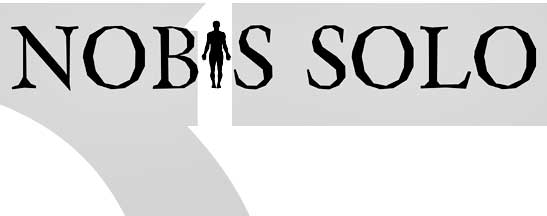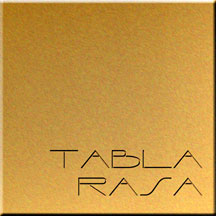

 |
|||
 |
|||
|
info@TablaRasaGallery.com
Joe Zuccarini Floating Dream 90"x40"x12" FREE NOBIS SOLO Tabla Rasa Gallery is pleased to announce the opening of NOBIS SOLO, on Wednesday, November 12, 2008. NOBIS SOLO is an exhibition of sculpture, painting and works on paper, each work complete unto itself. Entitled in the Latin phrase for "By ourselves alone," the artworks that were selected emphasize a unity of concept and process. Although it can be said of any work of art that it must stand on its own, co-curators Joseph and Audrey Anastasi feel there is an ineffable quality of individuality that is evident in these particular pieces. "Each artist in their way, demonstrates an extraordinary connection with their medium and a mastery of technique, where form, content and material are one." Oneness is a spiritual term referring to the 'experience' of the absence of egoic identity boundaries. Among the artists exhibiting in NOBIS SOLO are Amina Ahmed, Tom Bennett, Ana Bianchi, Kathleen Hayek, Janine Nichols, Stephen Paul, Robin Ross, Linda Stein, and Joe Zuccarini. Tabla Rasa Gallery is FREE and open to the public. There will be an artists’ reception on Wednesday, November 12, from 5:30 until 8:30 pm. NOBIS SOLO remains on view through January 31, 2009. General gallery hours are noon until 5 pm on Thursday, Friday and Saturday. Call 718.833.9100 for holiday season & schedule updates. .
About the artists… Organic biomorphic forms; trees, weeds and roots are continual themes in the work of Amina Ahmed, who received her MA at Royal College of Art in London. She specialized in visual Islamic and traditional arts and was awarded the Barakat trust Prize. Her drawings have vitality and poetry. They are built with a dense repetition of stroke and a concentrated gesture. She says, "The drawings are whatever one wants them to be, Root ,Weed or a woman tangled in her unwanted hair. The roots evoke the ancient voice. I am beholden to Nature, how it is realized, revealed, unknown and sometimes hidden within and without us.” For Tom Bennett, a sense of activity and movement within his paintings and monotypes is essential. "The monotype lends itself to spontaneity and to an intuitive approach in art making." Influenced by Bacon, De Kooning, and Auerbach, and with a mastery of reductive painting technique, his figures live in an ambiguous narrative speaking to the subconscious. Ana Bianchi is a maker of characters: their portraits, their close-ups, and props, and their interactions with others. Born in Mexico, her art has a strong surreal component. She creates a personal mythology inspired in vivid saga-like dreams, history and flashing glimpses of unique objects and people she may have encountered in everyday life and in her travels. Her etchings reveal technical mastery, precise, clean drawing and classical balance of line silhouettes combined with volumetric shadowing and texture. Kathleen Hayek is motivated and inspired by the power of life to destroy and create itself endlessly. In most of her work, she is dialoguing with this fracturing, displacing, churning cycle—devastation to re-creation—of natural life force, attempting to find the beauty in destruction as well as creation. A native of Louisiana and Mississippi, her landscapes of memory and dreams are inspired by long drives on open road, along rolling terrain in all seasons. She uses symbolic markings of trees and horizon line, scraped into printing plates, building the landscape with layers of thin transparent colored papers of delicate texture and colored inks melded in the "chine collé" printmaking process. These are simple direct creations, done with utter spontaneity, joy and love of natural forms and color harmonies. Collagist Janine Nichols succumbed to scissor-happiness decades ago; lately, her works on paper consist of layered image transfers (made with various sticky tapes, soaked in water, then "aged" with wire- and With his latest work Stephen Paul has brought together various parts of his past experiences-his years in the mountains of the Southwest where he developed a love of painting landscapes, his work as a contractor where he developed a love of the tools of demolition, and his life in painting. In this series he explores the relationship between destruction and creativity. He applies layers of paint and canvas then cuts back into the painting with a hand-held grinder. The abrasion exposes various layers of color and pattern from the different periods of the painting. Not always predictable, the results, considering the violent nature of the tool, can be quite subtle. The hauntingly beautiful paintings by Robin Ross encapsulate the mystery of life. At once abstract and representational, her seductive paint surfaces alternatively reveal and obscure figures and parts of figures, hovering between the spiritual and physical realms. They seem to take in the entire spectrum of consciousness; a transmigration from soul to soul. The concept of protection has permeated the sculpture of Linda Stein for the last three decades, evolving from her abstract Excavations and Blades series (1980's - 1990's) to the current Knights, that began to consume her after the evacuation by the police on 9/11. In this series she scrambles expectations of gender and power, blending female torsos into the mix of heroic symbols and archetypes. Her sculpture references three icons from popular culture and religion: Wonder Woman from World War II comics—a defending warrior who never killed in her efforts for justice; Princess Mononoke, from the popular anime movie—who inspires with her quest to save the environment; and Kannon, the androgynous Pan-Asian deity—who represents compassion and protection. Inspired by Michelangelo, Rodin, Munch, and referencing both eastern and western mythologies, Joseph Zuccarini arranges found and fabricated objects, rusted steel, broken glass, aged fabric, water, and transforms them into meditative, ritualistic sculpture. His rich palette of brown, orange rust, pale yellow and black, conjure the earthly elements, mortality, deterioration, and the passage of time.
|
|
|